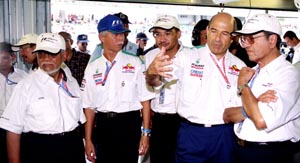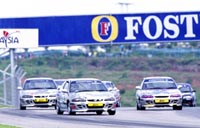
Story and Photographs by Roderick Eime
Whether it be boom or crisis, there's no ignoring Asia. Our near neighbours are asserting themselves in both the sporting and the economic arenas and their impact is being felt across the globe.
Since the end of World War Two, our Asian countries have progressively shaken themselves free of both real and perceived colonial shackles and set out to make their own mark on the world. Malaysia is one of the major kickers in the region and, love him or hate him, since 1981, the paternal Dr Mahathir bin Muhammad has been behind the country's drive to put itself on the main stage.
The former Portuguese, then Dutch, then British protectorate finally tore off its colonial apron strings in the late 1950s and began the often rocky road to complete independence. Now Malaysia's principal international flag bearer, the government-owned oil giant Petroliam Nasional Berhad (Petronas), operates in over twenty countries, including Australia, and on every continent except North America. Its high-profile collaboration with Peter Sauber's Swiss engineering operation and Formula One Team began in 1995 and also includes the co-development of a production 2-litre engine for Malaysian manufacture.
Petronas' motorsport activity not only trumpets their presence in the world arena, it binds their burgeoning oil and automotive industries with the perception of a high tech outlet for their efforts. After some toil, Malaysian engineers now crew with Red Bull Sauber and the hunt is on in earnest for a bumi putera (ethnic Malay) to get behind the wheel.
Rally, Touring Cars, Motorbikes and 4WD "adventure" make up the balance of Petronas' motorsport investment portfolio, all returning increasing dividends to the solitary shareholder.
In 1999 Malaysia broke new ground by hosting a round of the Formula One World Championship and took "Best Grand Prix of the Season" accolades for its effort. Now after its third event, the Sepang International Circuit (SIC) continues to receive lauded reviews by seasoned F1 observers.
"The event has now firmly put the country on the global map, not only as one of the world's top venues for motorsports, but also as one of the choicest tourist destinations," said the Chairman of Petronas, Tan Sri Datuk Seri Azizan Zainul Abidin, in his welcome to the visiting teams and media.
 It's true, the facilities at Sepang are arguably the best anywhere in the world, but the state-of-the-art facility still lacks a certain je ne sais quios. Even considering the recent impact of staging two Grand Prix inside of five months, crowds of any sort only arrive on race day and much of their number are made up of overseas tourists. The solitary one-make Proton race falls a long way short of a support programme and the ticketing system is unnecessarily restrictive and expensive, especially for locals. A programme costs the equivalent of A$20 and the average ticket price was around A$500.
It's true, the facilities at Sepang are arguably the best anywhere in the world, but the state-of-the-art facility still lacks a certain je ne sais quios. Even considering the recent impact of staging two Grand Prix inside of five months, crowds of any sort only arrive on race day and much of their number are made up of overseas tourists. The solitary one-make Proton race falls a long way short of a support programme and the ticketing system is unnecessarily restrictive and expensive, especially for locals. A programme costs the equivalent of A$20 and the average ticket price was around A$500.
Designed by German Architect, Hermann Tilke, SIC was built in just 13 months on 260 Ha of reclaimed palm oil plantations at a cost of nearly A$200M. The complex is directly adjacent Kuala Lumpur's International Airport, is owned and administered by KLIA, and a full hour by road from KL Central. The 5.543km circuit has 15 turns and 8 straights, each named not after famous drivers or even politicians, but exotic Malaysian locations like Kinabalu, Langkawi and Desaru. A lap of this demanding track can be completed in 1'37" by an F1, while the quickest of the Satrias managed 2'46".
"It looks easier than it is. It's very wide, and some of the turns look quicker than they. Set-up is difficult because of the mix of slow and fast corners," said Ralf Schumacher in a SIC press release.
 The expansive, gleaming stands and spotless grounds have something of a sanitised feel and, even when they are full, the event lacks that allusive "ambiance". Compared to the almost carnival atmosphere at the Australian Grand Prix, Sepang has a feeling of over-control. The same sorts of things are often said about superbly engineered Japanese sports cars, when compared to their sometimes-cranky Italian thoroughbred counterparts.
The expansive, gleaming stands and spotless grounds have something of a sanitised feel and, even when they are full, the event lacks that allusive "ambiance". Compared to the almost carnival atmosphere at the Australian Grand Prix, Sepang has a feeling of over-control. The same sorts of things are often said about superbly engineered Japanese sports cars, when compared to their sometimes-cranky Italian thoroughbred counterparts.
International Formula One Consultant, Stuart Sykes, who has more than twenty-five years of Grand Prix experience and was hired by Sepang, offers some balance;
"Despite staging their first Grand Prix at Johor in 1949, the organisers' are the first to admit that they lack a true motorsport culture in Malaysia. Having said that, Sepang is, certainly in my opinion, the only circuit anywhere in the world where the aesthetics have been considered above all else. It is a beautiful circuit and demonstrates the enormous pride Malaysians take in staging the event."
All in the paddock, teams and press alike, largely echo Sykes' comments, but it's not, and never will be, a decadent "party" event. Muslim Malaysia is too conservative for that. Which brings us back to motorsport culture!
Government presence also cannot be ignored, with Dr Mahathir "doing the rounds" of all the pit garages after qualifying as well as Malaysian royalty and sundry dignitaries putting in regular appearances. The pageant of red carpet, bodyguards and black limousines is constant over race weekend, rivalling the main event, and the omnipresent Petronas branding is overwhelming.
From a pure technical point-of-view, The Petronas Malaysian Grand Prix is hard to fault; save perhaps for the lack of toilet facilities for officials, but as Australia's closest overseas Grand Prix, it stands in stark contrast to our own event. Many Australians have already accepted Malaysia's open invitation to use the GP as an excuse for a holiday and several tour operators already take groups there. Despite some scary media reports, Malaysia is a relatively safe destination and despite some pilfering reported at Sepang hotels, visitors will never see the violent lawlessness so apparent at Sao Paolo in Brazil.
Official Web Sites:
[ Malaysian F1 Grand Prix ] [ Tourism Malaysia ]
Commissioned for Motor Racing Australia and published in Issue 59, June 2001.
|
|
|